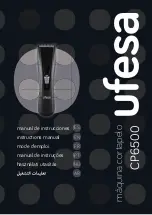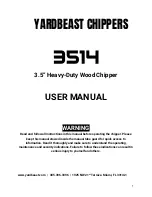
Chipping Branches
This chipper is designed to chip branches up to 90mm in diameter.
1.Start the engine (as per engine manual instructions) and allow the engine to gain optimum RPM
by sliding the throttle lever to ‘rabbit’.
2.The blade drum will start rotating as soon as the engine starts.
3.Feed long stems and long branches (ie. shrub and tree branches) into the Chipper Hopper (1)
for chipping by the rotating blades.
4.When feeding branches listen to the engine RPM and watch chips exit from the discharge chute.
Do not let the engine RPM drop too low or the blade drum may become clogged.
5.The chipper will chip branches up to 90mm in diameter. Branches with large diameters (closer to
and up to 90mm) will need to be fed comparatively slower than branches with a small diameter. If
large branches are feed into the chipper too fast the blade drum may stall and clog up.
6. Do not stand higher than the machine base
7. We recommend starting with smaller branches, and gradually increasing the size while you
become more familiar with the chipper and its capabilities
8. Pre-cut large side branches so that the branch will self feed more efficiently
9. Short pieces of timber tend to bounce around in the Chipper hopper (1). Feeding short pieces
together with longer branches reduces this.
10. Once you have become more accustom to the way your GX390 chipper operates, try to prune
your branches to suit the chipper.
11. If you are feeding soft materials into the chipper it is advisable to follow them with a more solid
branch. Mixing up the materials you want to chip will improve your chipping efficiency and reduce
potential blockages
.
11
12. For bushy branches, feed the non-bushy end into the chipper first
13. Immediately stop the engine if you notice any unusual noises or vibrations coming from the
machine.
14. Keep a wooden branch available (at least 650mm long) to assist in pushing materials through
the infeed chute.
15. Push the last branch you are chipping for the day all the way inside the Chipper hopper (1)
with a wooden tool (eg. wooden stick), and ensure it has been completely chipped before turning
off the machine. Leaving unchipped branches in the Chipper hopper (1) can cause problems when
you next start the machine.








































